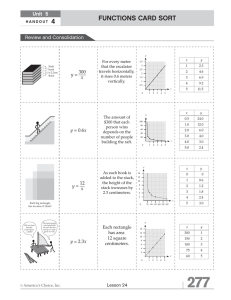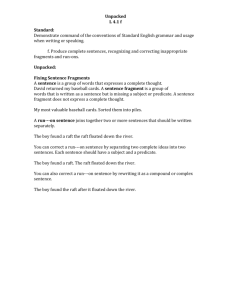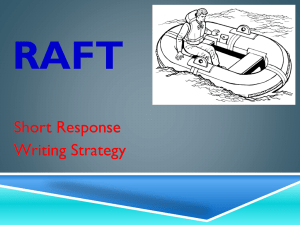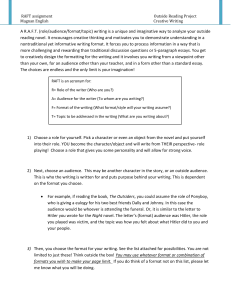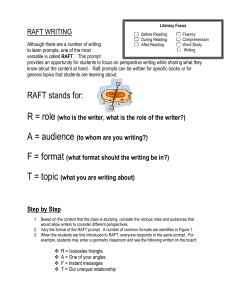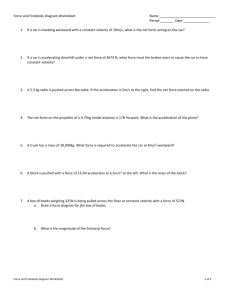Document 13730961
advertisement
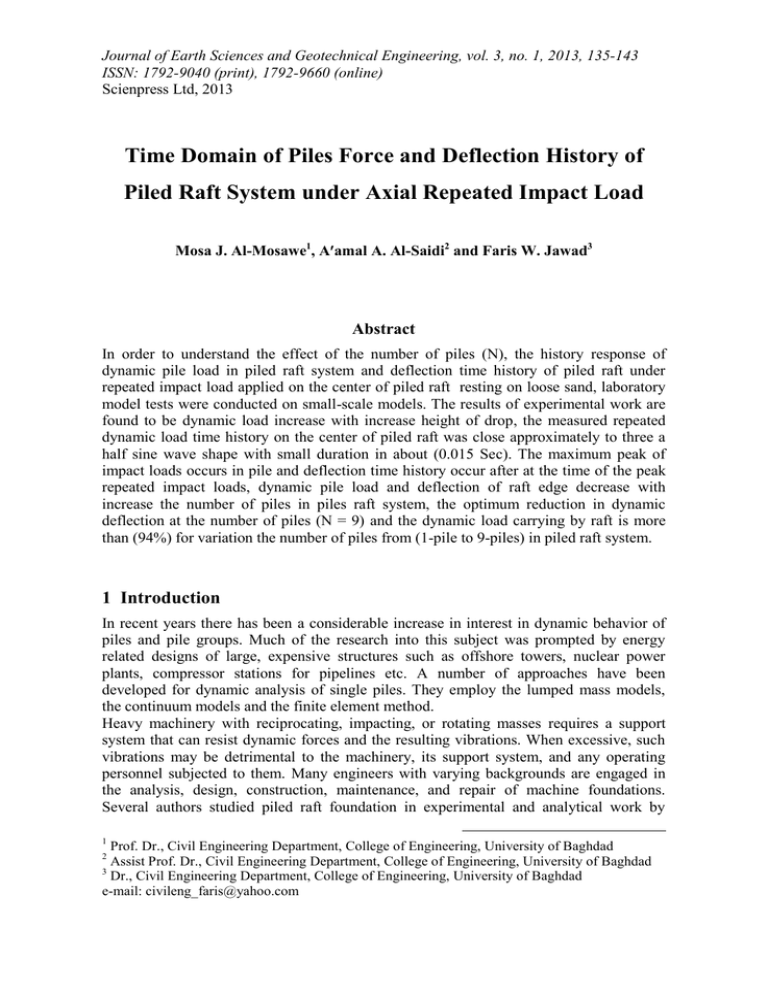
Journal of Earth Sciences and Geotechnical Engineering, vol. 3, no. 1, 2013, 135-143 ISSN: 1792-9040 (print), 1792-9660 (online) Scienpress Ltd, 2013 Time Domain of Piles Force and Deflection History of Piled Raft System under Axial Repeated Impact Load Mosa J. Al-Mosawe1, Aamal A. Al-Saidi2 and Faris W. Jawad3 Abstract In order to understand the effect of the number of piles (N), the history response of dynamic pile load in piled raft system and deflection time history of piled raft under repeated impact load applied on the center of piled raft resting on loose sand, laboratory model tests were conducted on small-scale models. The results of experimental work are found to be dynamic load increase with increase height of drop, the measured repeated dynamic load time history on the center of piled raft was close approximately to three a half sine wave shape with small duration in about (0.015 Sec). The maximum peak of impact loads occurs in pile and deflection time history occur after at the time of the peak repeated impact loads, dynamic pile load and deflection of raft edge decrease with increase the number of piles in piles raft system, the optimum reduction in dynamic deflection at the number of piles (N = 9) and the dynamic load carrying by raft is more than (94%) for variation the number of piles from (1-pile to 9-piles) in piled raft system. 1 Introduction In recent years there has been a considerable increase in interest in dynamic behavior of piles and pile groups. Much of the research into this subject was prompted by energy related designs of large, expensive structures such as offshore towers, nuclear power plants, compressor stations for pipelines etc. A number of approaches have been developed for dynamic analysis of single piles. They employ the lumped mass models, the continuum models and the finite element method. Heavy machinery with reciprocating, impacting, or rotating masses requires a support system that can resist dynamic forces and the resulting vibrations. When excessive, such vibrations may be detrimental to the machinery, its support system, and any operating personnel subjected to them. Many engineers with varying backgrounds are engaged in the analysis, design, construction, maintenance, and repair of machine foundations. Several authors studied piled raft foundation in experimental and analytical work by 1 Prof. Dr., Civil Engineering Department, College of Engineering, University of Baghdad Assist Prof. Dr., Civil Engineering Department, College of Engineering, University of Baghdad 3 Dr., Civil Engineering Department, College of Engineering, University of Baghdad e-mail: civileng_faris@yahoo.com 2 136 Mosa J. Al-Mosawe, Aamal A. Al-Saidi and Faris W. Jawa different materials such as concrete model Katzenbach et al[1], (1997) and aluminum model, Giretti[2], (2009). In this paper, in order to examine the effect of the number of piles on the behavior of piled raft in sand, experimental work was carried out. The parameters studies at (Lp/dp= 14.18, tr=15mm and Dr = 30%) where Lp= pile length, dp = diameter of pile (dp=14.1mm), tr= thickness of raft and Dr=relative density are: 1) 1-piled raft, 2) 2- piled raft at (s=3dp) where s=spacing between piles, 3) 3- piled raft at (s=3dp), 4) 4- piled raft at (s=3dp), 5) 6- piled raft at (s=3dp) and 6) 9- piled raft at (s=3dp). 2 Experimental Tests The impact test was designed and manufactured to satisfy the requirement of the experimental program (see Plate (1)). Each specimen was subjected to three levels of drop height which respectively were: (500,900, and 1300mm). The mass of the striker was (6.2 kg) for the three drop levels and the test was repeated for the three drop levels. Plate (1): Impact test setup 1. Digital Storage Oscilloscope 2. Digital Strain Indicator 1 Chanel Time Domain of Piles Force and Deflection History of Piled Raft System 3. 4. 5. 6. 7. 8. 137 Strain Indicator 4 Chanel Boards of LVDT Computer Device Manufactured Impact Frame Sand Container Settlement measurement The square aluminum raft model was a 120mm in dimension and thickness (tr=15mm). The square cross section aluminum model of piles employed in the tests (dp=1.41mm) as shown in Plate (2). Plate (2): The square aluminum raft model, piles and the screwed opening to fix piles The model of raft and piles were instrumented with strain gauges for moment and axialload measurements, respectively. Plate (3) shows the instrumentation of strain gage in the bottom of raft in two direction near from the center of applied load and for piles the instrumentation consists of two levels of strain gauges mounted on the external surface of the aluminum pile were mounted at the first level and bottom level to measure the axial forces at the pile head and the pile toe. Plate (3): The aluminum model with strain gage Before bonding the strain gage, the pile surface was smoothed and cleaned by alcohol (see Plate (4)). The surface of pile was coated by epoxy resin to protect the strain gauges. 138 Mosa J. Al-Mosawe, Aamal A. Al-Saidi and Faris W. Jawa Thus each model pile was tightly secured through openings in the raft using screws to create a fixed-head condition. The half Wheatstone bridge circuit was used for strain gages connection, Dally et al. [3], (1965). Plate (4): The instrumentation of strain gage 3 Soil Used 3.1 Sand Properties Clean, oven-dried, poorly graded sand was used in the tests. The sand was placed in the test box at unit weight of approximately 15.3 kN/m3 (relative density=30%). Some properties of sand are given in Table (1). Time Domain of Piles Force and Deflection History of Piled Raft System Table (1): Properties for Sand Used. Property Specific Gravity, Gs 139 Values 2.65 Maximum unit weight, γdmax 17.9kN/m3 Minimum unit weight, γdmin 14.4 kN/m3 Maximum void ratio (emax) 0.81 Minimum void ratio (emin) 0.45 Dry Unit Weight Used (γd) Loose state, γdused 15.3 Void Ratio Used (e) Friction Angle Loose state (eused) Loose state 0.73 28.81◦ Dry Unit Weight (γd) of Sand Void Ratio(e) of Sand 4 Results and Discussion of Experimental Work Figure (1) shows the relationship of measured repeated dynamic load - time history is applied on the center of footing (1-piled to 9-piled raft). The repeated load is generated from drop the weight from three different heights at first from 500mm, 900mm at second and lastly from 1300mm and the time rest (free vibration) between two successive shock is about (0.7sec) are neglected from drawing to get more resolution for variation the load with time). 1.0 0.9 Repeated Impact Load (kN) 0.8 0.7 0.6 0.5 0.4 0.3 0.2 0.1 0.0 0.000 0.004 0.008 0.012 Time (Sec) Figure (1): Repeated Dynamic Load Time History 0.016 140 Mosa J. Al-Mosawe, Aamal A. Al-Saidi and Faris W. Jawa Figures (2 to 7) show dynamic load time history of piles in piles raft and dynamic deflection time history from the tests of piled raft with the number of piles variation from (1-piled to 9-piled raft) at repeated load is applied on the central of footing. It is clear that the dynamic pile load and deflection of raft edge decrease with increase the number of piles in piled raft system, and the optimum reduction in dynamic deflection at the number of piles (N = 9) and the dynamic pile load is the same value at any location of pile in geometry of piles raft system with small time lag. Table (2) show that the dynamic load carrying by piles in piles raft and the percentage of dynamic load carrying of each element use in design of piled raft system at (tr = 15mm). It is clear that the raft dynamic load carrying is more than (94%) for variation the number of piles from (1-piled to 9-piles) in piles raft system at raft thickness (tr = 15 mm). Table (2):The Percentage of Dynamic Load Carrying of Each Element in Piled Raft. Percentage of Percentage of Max. Dynamic Max. Dynamic Geometry of Piled Dynamic Load Dynamic Load Load Applied, Load of Piles, Raft Carried by Carried by (kN) kN Piles, (Ped%)* Raft, (Ped%)* (1) Piled Raft 0.88 0.027 3.1 96.9 (2 x 1) Piled Raft 0.88 0.054 6.1 93.9 (3 x 1) Piled Raft 0.88 0.056 6.4 93.6 (2 x 2) Piled Raft 0.88 0.064 7.3 92.7 (3 x 2) Piled Raft 0.88 0.066 7.5 92.5 (3 x 3) Piled Raft 0.88 0.084 9.5 90.5 *(ped) = (dynamic load carrying by element / total dynamic load applied) *100%} Figure (2): Repeated dynamic load and deflection time history for 1-piled raft Time Domain of Piles Force and Deflection History of Piled Raft System Figure (3): Repeated dynamic load and deflection time history for 2-piled raft Figure (4): Repeated dynamic load and deflection time history for 3-piled raft Figure (5): Repeated dynamic load and deflection time history for 4-piled raft 141 Mosa J. Al-Mosawe, Aamal A. Al-Saidi and Faris W. Jawa 142 Figure (6): Repeated dynamic load and deflection time history for 6-piled raft Figure (7): Repeated dynamic load and deflection time history for 9-piled raft Conclusion Dynamic load increase with increase height of drop The measured repeated dynamic load time history on the central of piled raft was close approximately to three a half sine wave shape with small duration in about (0.015 Sec). Time Domain of Piles Force and Deflection History of Piled Raft System 143 The maximum peak of impact loads in pile and deflection time history occurs after at the time of the peak repeated impact loads. Dynamic pile load and deflection of raft edge decrease with increase the number of piles in piled raft system, and the optimum reduction in dynamic deflection at the number of piles (N = 9). For piles group raft the dynamic pile load not depend on the location of pile in geometry of piled raft. The raft dynamic load carrying is more than (94%) for variation the number of piles from (1-piled to 9-piles) in piled raft system. The percentage of dynamic load carrying by piles increase with increase the number of pile up to (N=6). References [1] [2] [3] Katzenbach, R. & Arslan, U. & Gutwald, J. & Holzhäuser, J. (1997)."Soil-structureinteraction of the 300 m high Commerzbank tower in Frankfurt am Main, Measurements and numerical studies". Proc. of the Fourteenth Intern. Conf. on Soil Mech. and Found. Eng., Hamburg, 6-12 September 1997: 1081-1084, Rotterdam: Balkema. Daniela Giretti (2009) "Modeling of Piled Raft Foundations in Sand" Ph. D. Thesis, University of degli Studi di Ferrara. Dally, J.W., and Riley, W.F. (1965), "Experimental Stress Analysis" McGraw-Hill Book Company.
